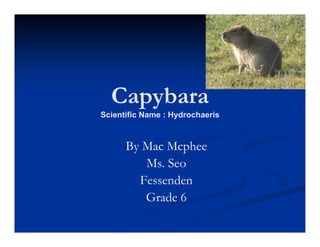
Mac capybara3
- 1. Capybara Scientific Name : Hydrochaeris By Mac Mcphee Ms. Seo Fessenden Grade 6
- 2. Scientific classification Kingdom: Animalia Phylum: chordata Subphylum: vertebrata Class: mammalia Order: rodentia Suborder: hystricomorpha Family: caviidae Subfamily: hydrochoerinae Genus: hydrochoerus Species: H. hydrochaeris
- 3. appearance Small eyes on the top of there head Small rounded ears Heavy rounded body No tail Sharp front teeth Feet are slightly webbed Four toes on front Three toes on back
- 4. Location in world Capybaras are located in south America and also panama. Capybaras are found in dense forests near water sources such as streams, rivers, ponds, swamps and lakes.
- 5. Life cycle About 18 months old capybara herd it is only the dominant male that has the breeding rights to the year round females. and although it can occur all depending on the conditions the breeding season is usually in April and May. after pregnancy period that lasts around five months the female capybara gives birth to between 1 and 8 pups on land capybara young are very well developed at birth. and not only have all their fur and can see but are also able to run swim and dive within hours of birth the female rejoins the main group within hours with her newborn babies
- 6. What does it eat Capybaras are herbivores they eat leaves and fruit and also plants from the bottom of rivers and lakes? Capybaras are strictly vegetarian
- 7. Predators Their predators are jaguars, caimans, and snakes like anacondas which usually eat small capybaras
- 8. How does it contribute to the diversity of life Capybara play a number of important roles in their ecosystem. In many parts of their range they are the only large grazing species so they have a huge impact on the vegetation of the area They also serve as a prey animal for many large carnivores many birds eat the insects found in capybara fur and insects
- 9. How do humans continue to impact the natural environment of the capybara They are often killed in certain areas for their meat and skin which has led to population declines in these regions The capybara has also been affected by human activity in their native regions in general including both growing human settlements Land clearance for agriculture it is in these areas that when there is not an adequate supply of food available
- 10. What can be done to help this species continue to survive Don’t pollute in capybara water and do not pollute in there forest or it will kill them
- 11. Interesting facts The capybara is the worlds largest rodent Three toes on the back Four on the front
- 12. Final slide Rainforest animals www.rainforestanimals.net Wikipedia www.Wikipedia.com Smithsonian animals (David buhie and don e Wilson) Animals of the world (tom Jackson)
- 13. The end